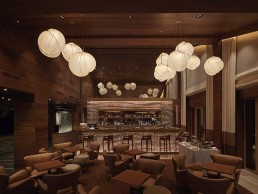
Four Seasons Hotel, France
Jeremy Maxwell Wintrebert collaborated with interior architect Pierre Yves Rochon to bring a sense of fairytale and wonderment to the new Four Seasons Megève.
The Four Seasons Hotel Megève in the heart of the French Alps lies directly on the Mont d’Arbois ski slopes. This modern chalet builds on the legacy of the Rothschild family who set out to create an unrivalled resort experience nearly a century ago. Distinct French character, pure Alpine tradition and an intimate and inviting setting in both summer and winter define this mountain retreat. Guests can play at one of the world’s finest Alpine golf courses, relax in the region’s largest spa and dine at two Michelin star restaurant Le 1920.
Craftsman and glass blower, Jeremy Maxwell Wintrebert was asked by Madame de Rothschild herself alongside the hotel’s interior architect and decorator Pierre Yves Rochon, to take part in the hotel project. Having proposed pieces of his collection for different areas of the hotel, Wintrebert then worked to adapt them to suit the spaces accordingly, as well as realising an entire site-specific installation in the form of Crying Willow.
“I imagined the hotel guests having a fairytale-like experience and I found inspiration in the natural location and surroundings of the hotel, which is high up on a mountain, surrounded by very dramatic and incredible mountain ranges. The mountains and sky are like canvases for the ever-changing light that reflects off them. The array of colours sometimes change minute by minute and can go from dark grey to gold or from bright oranges to dark purples to everything in between.”
Every single piece of the project – from the lighting fixtures to the glass used – is entirely handmade, which Wintrebert explains is always an immense challenge in itself. “I am lucky to work with incredibly skilled people such as the team at Mydriaz Paris, who make the brass and my team with whom I blow these incredible pieces in my studio in Paris. I was very fortunate that the clients were so open and trusting of my work and gave me complete freedom… although, that itself can turn into a challenge.
“As a glass blower I always imagine the work as a sculpture first. Sometimes the work simply stays a sculpture, like Crying Willow, which doesn’t have a light source inside but which plays with the light that comes from different spotlights. Either way, the lights are all decorative so I stayed with 2700K for almost all the lights. The exception was with the Clouds pendants, which needed to be slightly warmer and for which we developed a unique temperature. Since all our LEDs are custom made, we can really research and produce very bespoke light effects. For projects like a hotel, it’s almost always going to be warm, cosy lighting. Almost all the lights are dimmable and sometimes on a program that adapts to different times of the day.”
While the selection process might have been smooth and straightforward, as with most lighting projects, the actual installation did highlight some structural issues. For example, the Clouds pendants had to be hung on a sloped ceiling, which affected the hanging mechanism and actual installation. Then, the Crying Willow sculpture in the wine cellar, which is made of thousands of handmade glass threads and is almost three meters, needed to be assembled and hung inside a circular room made of glass and a metal structure with very odd proportions and underground with very difficult accessibility.
But, the most difficult issues with the placement and structural constraints, according to Wintrebert were with the Solstice wall lights around the pool. “Each light weighs over 70kg and needed to be fixed through a thin marble wall, which was textured and not flat. I collaborated with Mydriaz Paris who designed the brass so they could be hung safely but handled easily for maintenance, while enduring a humid environment.”
Looking back on the final design, for Wintrebert, the project reinforces his sculptural approach to lighting as a craftsman. “I believe it adds a very sensitive quality to the experience of the space and celebrates the handmade quality that is so rare in lighting, which often has a very industrial feel to it because it has been designed on a computer then made separately with very precise specifications.
“I love that on the scale of a project like this, the sculptural handmade quality is celebrated and very noticeable. I believe that the guest doesn’t notice the lights at first but experiences the expressive, creative work where emotion prevails over function and therefore becomes an actor in a part of the fairytale.
“I have never before had the opportunity to propose so many different lights for one project and have them all work together,” concludes Wintrebert. “I believe the stand out feature is the 30 Clouds installation over the bar and 1920 restaurant. I was very lucky to also collaborate with chef Julien Gatillon to create the tableware collection for his restaurant, which is directly inspired from his cuisine and the hanging 30 Clouds above.”



